Thursday, December 08, 2005
U.S. NGOs versus French Associations
In France, organizations involved in humanitarian work rarely fall in to the category of NGO. Actually, most all of them lie in the grey area in between government-sponsored and private. France, a social State, upholds a system of solidarity. This means State monies (coming from taxation mostly on families and businesses) are set aside specifically to help those in need.
The government has also gone through a process of decentralization so that these government funds are accessible at all levels… regional, departmental and municipal. Therefore, each community can see what their specific needs are and finance projects/missions in those areas. By in large, it is associations who apply for these funds by presenting their service (offre de service) to either the mayor or a general council. There are associations that operate nationally such as l’ASSFAM, whose basic mission is to anticipate problems specific to new immigrants and take proactive measures to help resolve them (individually and collectively). Offices are located in several departments in France but are linked to the central headquarters in Paris. There are associations who operate internationally, such as l’AFVP who recruits volunteers in universities and technical institutions to participate in development projects all over the world. And there are a MULTITUDE of associations acting independently on the local level, people of a neighborhood joining together for a common goal. Associations can be religious in nature, sportive, cultural, charitable, political, etc. There are quite a few associations considered “militant”, meaning they actively fight for a specific cause: women's rights, immigrant's rights, etc. Associative life in France is the backbone of their system of solidarity, their belief that everyone should share in the responsibility of caring for the disadvantaged (poor, handicapped, elderly, minorities) and defending individuals’ rights.
Since most of the associations funds come from government aid, usually in the form of contracts renewed yearly, some of their autonomy is taken away. For example, l’ASSFAM had to completely reframe their mission in their 2006 proposal because of the political current of toughening up on immigration policy. However, a positive to this close tie with elected officials (in all levels of government) is that it makes it necessary for an association’s projects to stay transparent. This then lends to efficiency and accountability. It also allows for great collaboration amongst organizations and people of the community. L’ASSFAM has a whole list of partnerships they’ve developed within their individual localities to help accomplish their goals. This visibility and coordination makes it much easier to effectively tackle problems.
Now, coming back to the American conception of NGOs. Basically, in the US, where a capitalistic, privatized system rules the day, NGOs take the place of government supported structures to fill socio-economic gaps. Some NGOs and/or our famous 501(c)s get government subsidies but to a much greater extent, they exist due to the financial contributions coming from private sources. The most important donors are usually foundations (Gates, Guggenheim, Heinz, Ford foundation). Yes, it is often times excessively rich companies and individuals who decide who gets the money and thereby what humanitarian efforts are worthy of support. That is why, in the States, grant writing has become an extremely important profession. As is tradition in the good ol’ US of A, the procedure is very competitive and often times political. NGO’s needing sponsorship must learn how to sell themselves, to network, and to present their service as a product.
On the one hand, this probably raises standards globally. Organization must really make the case that their cause is important and that they are capable of making changes. Also, since sums come from the private sector (and not directly tied to public demands), there is less constraints on a NGOs activities. This probably encourages people to get involved in humanitarian work. But on the other hand, foundations act as separate entities, giving their support to who they will, and thereby fragment efforts. And, unfortunately, small players, those with the closest ties to local communities don’t make it in the running. To secure funding is to have influence. All these negatives are why in a country as wealthy as the US, we have an astonishingly high rate of poverty, illiteracy, troubled teens, gangs, etc. Communities that most need resources have no outlet. In France, financing of associations is adapted specifically to each communities needs. Granted, France has its share of problems, but considering the very high employment rate and the huge immigrant population, they make out o.k. In my master’s thesis I am going to try to show (I only have statistics proving it for a couple city’s right now) that banlieus with greater presence of associations correlated with less violence during the recent rioting.
Voila for now… Please, I encourage your feedback… any and all comments are welcome.
Afterthought: Private sectors contributing to NGOs are often times tax write-offs so it would appear that in the end the US government largely finances the aid sector like in France... So the only big difference is, in the US those who have capital choose who will get the monies, in France elected officials in each community have a budget for financial aid and can distribute it according to need. hhhmmmmm.....
Tuesday, December 06, 2005
Lyon
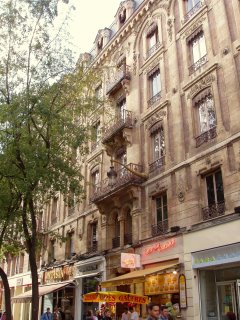 As promised, finally a blog on Lyon, Yann's hometown. I hadn't heard much about the city before going, so I wasn’t too sure what to expect. I was very pleasantly surprised. It resembles Paris in that it has a vibrant restaurant scene, lots of great shopping, a lovely river (actually two) crossing through it (keeping me perpetually confused, unable to figure out which was which).
As promised, finally a blog on Lyon, Yann's hometown. I hadn't heard much about the city before going, so I wasn’t too sure what to expect. I was very pleasantly surprised. It resembles Paris in that it has a vibrant restaurant scene, lots of great shopping, a lovely river (actually two) crossing through it (keeping me perpetually confused, unable to figure out which was which).

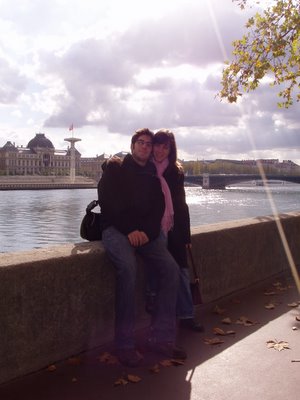
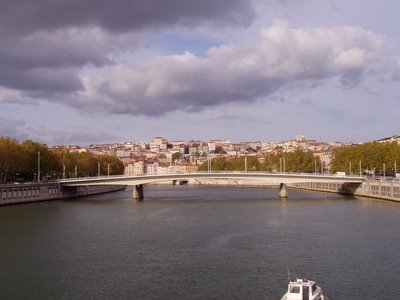
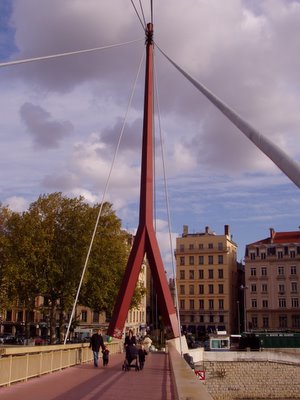 However, Lyon is smaller, much cleaner and a stone's throw from the beautiful countryside. Some of its most distinguishable features are the provincial style rose/reddish roofs covering the whole of the city and the hillyness creating a layering affect, giving the town depth and contrast. Both can be appreciated going up towards Croix Rousse, where you will stumble upon super old Roman ruins and eventually reach a (not so old) immense white Baroque-stlye Basilica, Notre Dame de Fourvière.
However, Lyon is smaller, much cleaner and a stone's throw from the beautiful countryside. Some of its most distinguishable features are the provincial style rose/reddish roofs covering the whole of the city and the hillyness creating a layering affect, giving the town depth and contrast. Both can be appreciated going up towards Croix Rousse, where you will stumble upon super old Roman ruins and eventually reach a (not so old) immense white Baroque-stlye Basilica, Notre Dame de Fourvière.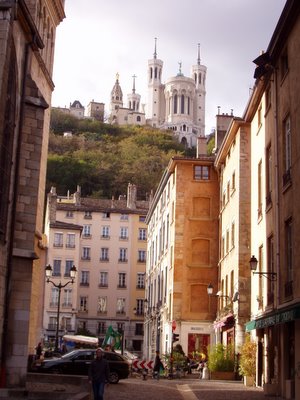

 Yann, and surely many other Lyon residents, thinks this big white domed-block on the top of the hill is distasteful and ridiculous. It absolutely perturbs him that they would dare build a church as late as the 18th century in such a style... there is no baroque influence in Lyon! Nonetheless, though my Lyonnais friend will never admit it, the originality of the church alone makes it quite impressive and the mosaics adorning the interior's walls are sublime.
Yann, and surely many other Lyon residents, thinks this big white domed-block on the top of the hill is distasteful and ridiculous. It absolutely perturbs him that they would dare build a church as late as the 18th century in such a style... there is no baroque influence in Lyon! Nonetheless, though my Lyonnais friend will never admit it, the originality of the church alone makes it quite impressive and the mosaics adorning the interior's walls are sublime.
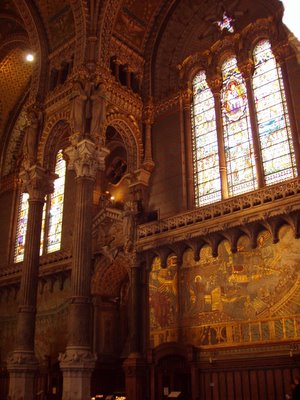

So, for Yann, I will also mention the ol' "respectable" gothic-style cathedral (Saint-Jean) found down below which houses one of the oldest clocks in the world (13th or 14 century). It operates based on an astronomical calendar, functioning with most of its original parts.
-
-
In the old section of Lyon, the cobble streets and medieval style buildings are in pristine condition. Even though a great deal of commerce is geared towards tourists, it still holds a lot of charm. One neat feature about the town is that there are a lot of hidden passage ways that cut vertically through the stone-lined streets. Apparently, back in the day this made transporting weaving materials and goods through the town much easier. For a long period, Lyon's wealth came from its textile production.
Lyon is also known for its excellent cuisine. Yann said we'd eat well and he did not let me down. We had a very nice meal in one of Lyon's traditional-style restaurants called "bouchons".

 But, more important than appreciating Lyon's loveliness was getting to meet and spend some time with Yann's parents in their home. The house is welcoming... spacious and comfortable with a lovely garden in the back. His parents are fortunate... their professions (both doctors), 3 beautiful children and life-styles afford them a really superb quality of life. While enjoying good food and fantastic wines over dinner and sipping tea in their cozy den, I had the opportunity to hear about the family’s adventures and travels. Conversations were always lively with Yann's father, who loves to talk... the man seems to know something about everything. Now I now where Yann gets it from! Yann's mother is very sweet... she is an excellent example of a woman who manages to balance her career and caring for her family. And, I really enjoyed testing out her new oven that uses induction to heat. Somehow it only warms metal so even when on high you can still touch the burner with your hand. Way cool.
But, more important than appreciating Lyon's loveliness was getting to meet and spend some time with Yann's parents in their home. The house is welcoming... spacious and comfortable with a lovely garden in the back. His parents are fortunate... their professions (both doctors), 3 beautiful children and life-styles afford them a really superb quality of life. While enjoying good food and fantastic wines over dinner and sipping tea in their cozy den, I had the opportunity to hear about the family’s adventures and travels. Conversations were always lively with Yann's father, who loves to talk... the man seems to know something about everything. Now I now where Yann gets it from! Yann's mother is very sweet... she is an excellent example of a woman who manages to balance her career and caring for her family. And, I really enjoyed testing out her new oven that uses induction to heat. Somehow it only warms metal so even when on high you can still touch the burner with your hand. Way cool.
Our last day, we shared what Yann calls a typical Sunday... a rather large lunch and a fun family excursion. Ahhh, how relaxing... wake up late, eat a nice meal together, drink a strong coffee before heading out to the countryside for a brisk hike. Lyon is right near wine country. Yann's dad took us up and down windy roads (at race car speed, eeeeekkk!) to a spot with a few different trails and lots of great views. In this semi-mountainous region you can find pre-historic fossils of mollusks from when the area was submerged by sea water. We gathered up quite a few during our walk. Though my search was not as fruitful as Barbara's magnificent find, I found inspiration in a bright orange snail shell I collected from the wood's damp floor. Our mushroom hunt was much less successful, all three of us came up empty handed.

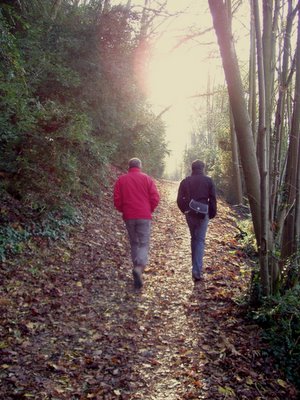
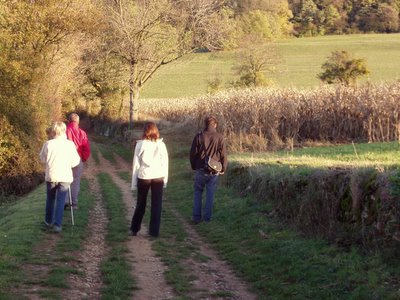 All in all, a very nice trip... a peaceful place to think and a welcome change in scenery during the 11 days of banlieu rioting.
All in all, a very nice trip... a peaceful place to think and a welcome change in scenery during the 11 days of banlieu rioting.
Monday, December 05, 2005
Immigration policy... pre-reflection
REFLECTIONS - immigration in the metropole

Hard to believe, I only have one week left at l’ASSFAM. I’m quite sad. The relationships I’ve formed with my chères colleagues these last 3 months are so dear to me. I’ve learned a great deal from them. I also got a real peek in to the hidden demographic of Paris… struggling peoples coming from all over the world, making huge sacrifices to come to France and then trying to legitimize their abysmal existence.
I’ve decided to reflect upon my activities, the things I saw, the stories I heard in the form of a short paper. This is why I’m starting with an explanation of the cases we deal with concerning French immigration legislation. Afterwards, I’ll more easily be able to explain the specificities of situations we encountered. First important fact,
FRANCE CLOSED ITS BORDERS IN 1974, OFFICIALLY ENDING IMMIGRATION. Since, non-French persons are only allowed to come and live in France if they meet very specific criteria. The most common procedure is family reunification.
CASE: LEGALIZATION OF SANS PAPIERS
Everyday we field dozens of phone calls and have appointments with people asking for help with a myriad of problems. Many want to know exactly what they need to do to get legal status. In a lot of instances, people are sent to us by someone who knows they have a chance of getting papers, but only if their request is filed with impeccable credentials. There are but a few ways in, and the conditions are strict. For example, if an immigrant is asking for a residence permit under the pretext of medical necessity, he must justify that his illness is severe enough that he needs regular check-ups and that medical care in his home country is not suitable to treat him. In order for him to have a chance, he needs a medical certificate signed from a doctor working in the government sector dealing with immigrants to validate his situation.
Another example, a young Hatian woman has a baby with another Haitian “sans papier”. They have been living in France clandestinely for 6 years. A recent French law allows for the possibility of a residence permit if you can prove 5 years of stable, communal family life. The only way the request will be taken seriously is if all the documents proving presence on French territory are very official. You have to have at least 2 proofs a year (one for the first and second part of the year). If you are not part of a family but have been present on the French territory for 10 or more straight years, and can prove it well, you can also file a request for papers. These are just the base conditions for a very long, complicated procedure that must be executed with the utmost care. In short, it is very, very difficult to get a positive decision from the Prefecture (administrative body ruling over decision to give resident permits). A large percent of the cases we deal with at L’ASSFAM are appeals made after an immigrant received a refusal or was given expulsion papers.
 There are a couple other special cases we often confront. First, there are those immigrants trying to get refugee status. This requires them to prove the argument that their life is in danger in their home country usually due to their political position. Second, immigrants who can show their baby has a French parent (either mother or father), making the child necessarily French, automatically fall under the category of ‘parent of a French child’. Parents of French children are systematically given permission to live in France. This is probably the most exploited of all the conditions which allow one legal status. Great numbers of women from sub-Saharan Africa, especially Cote-D’Ivoire, come to France with a tourist Visa, get pregnant and after the baby is born find a French man to claim the child as his. The law requires only a signed acknowledgement the child is yours. She can then begin the process of legalization and after, tap in to the social system which will allocate to her a nice monthly sum. But, it isn’t all that simple. Women must put themselves in compromising situations in order to first get pregnant and then bribe a French person to claim the baby, even in cases when it is really his. Of course, it doesn't always work this way, but I must say I was astonished by the number of women who had a French baby, the father nowhere to be found.
There are a couple other special cases we often confront. First, there are those immigrants trying to get refugee status. This requires them to prove the argument that their life is in danger in their home country usually due to their political position. Second, immigrants who can show their baby has a French parent (either mother or father), making the child necessarily French, automatically fall under the category of ‘parent of a French child’. Parents of French children are systematically given permission to live in France. This is probably the most exploited of all the conditions which allow one legal status. Great numbers of women from sub-Saharan Africa, especially Cote-D’Ivoire, come to France with a tourist Visa, get pregnant and after the baby is born find a French man to claim the child as his. The law requires only a signed acknowledgement the child is yours. She can then begin the process of legalization and after, tap in to the social system which will allocate to her a nice monthly sum. But, it isn’t all that simple. Women must put themselves in compromising situations in order to first get pregnant and then bribe a French person to claim the baby, even in cases when it is really his. Of course, it doesn't always work this way, but I must say I was astonished by the number of women who had a French baby, the father nowhere to be found.Those who have the greatest chance of receiving permission to live in France are those who do it through the Regroupement Familiale (family reunification) procedure. If an immigrant has had a residence permit for at least 2 years and meets other specific requirements, they can request their children (under 18) and/or spouse to join them in France. Lodging must be large enough to house the newcomers comfortably and they must make a minimal monthly salary of approx. $11,000. French Nationals can of course marry a foreigner and their spouse will receive a green card. French nationals can also request to have their non-French parents join them in France.
In the mix of a lot of legislative counsel, we piece together the diverse migratory stories of the many people that pass by our small office. Days I sit in for 4-6 appointments fill my heart with heavy emotion. Life as an immigrant can be tough, life as a “sanspapier” is much tougher. I have a thick notebook full of all the different situations I’ve encountered while at l’ASSFAM.
In an upcoming blog, I will share some of these stories with you. I’ll also bring up questions they made me ask myself… for example, why the heck do people come to France, especially Paris, if life is so difficult? No housing. No jobs. No money. Overcrowded schools. Run-down public spaces. Is France really pictured as an “El Dorado” in the mind of millions of people to its south and east? Is there such a thing as an over-saturation of immigrants causing a society to fall in to disequilibrium? What are the most durable and efficient ways to reduce the level of social malaise plaguing immigrant-ethnic dense communities? My attempt to tackle these questions (and more) in blogs to come… hopefully in the not so distant future!

